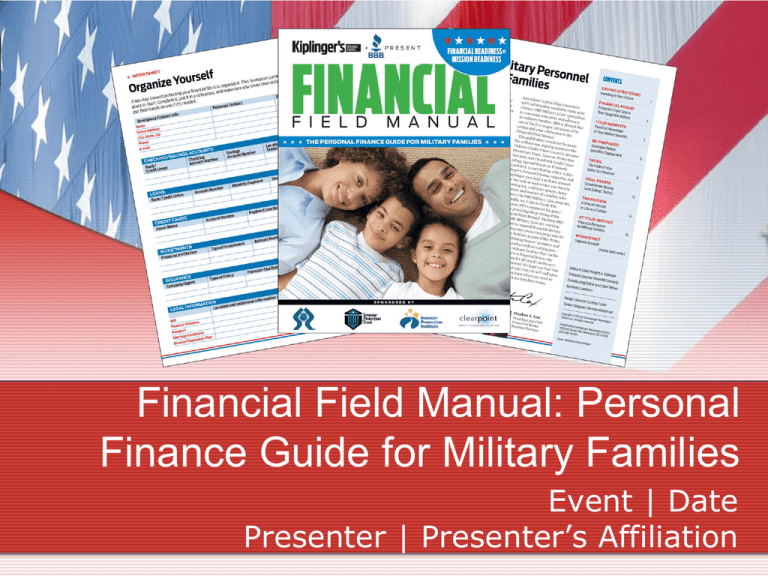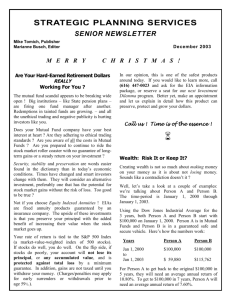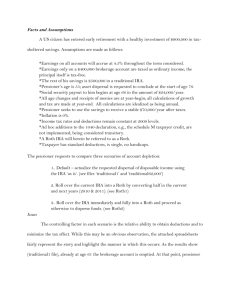Financial Field Manual: Personal Finance Guide For Military
advertisement

Financial Field Manual: Personal Finance Guide for Military Families Event | Date Presenter | Presenter’s Affiliation Invest in Your Future: Pension • Pension for 20 or more years of service. • As much as 50% of base salary if you retire after 20 years. • More if you stay past 20 years. • Less than 20 years of service: $0. Financial Field Manual: The Personal Finance Guide for Military Families Invest in Your Future: Thrift Savings Plan (TSP) • The easy way to pay yourself first! • Low-cost, tax advantage retirement plan similar to a private company’s 401(k) plan. • Pre-tax contributions cost less than you think. • You may contribute up to $17,000 to the TSP in 2012. • You may contribute up to $50,000 if you receive tax-exempt pay while serving in a combat zone. • Contributions grow tax deferred until you withdraw the money in retirement. Financial Field Manual: The Personal Finance Guide for Military Families Invest in Your Future: Investing inside the TSP • You can choose among five index mutual funds that invest in: • Large companies • Small companies • International firms • Bonds • Government securities • Or, you can choose a lifecycle fund (called the L fund), which builds a diversified portfolio of the other funds. Financial Field Manual: The Personal Finance Guide for Military Families Invest in Your Future: The power of compounding • Start early. • $10,000 contributed this year would grow to more than $100,000 over 30 years, if your investment grows at an average rate of 8% per year. • An investment of $10,000 per year for the next 30 years will grow to more than $1 million. • Does an 8% annual return sound too good to be true? • The annual average return of the stock market since 1926 – a period that includes not only the recent Great Recession but also the Great Depression of the 1930s – is nearly 10%. Financial Field Manual: The Personal Finance Guide for Military Families Invest in Your Future: Roth IRA • Enjoy Tax-Free Income in Retirement • Roth IRA = Delayed Gratification • No deduction now but tax-free withdrawals in retirement. (Withdrawals from traditional IRA are taxed in your top tax bracket.) • You can withdraw contributions at any time tax- and penaltyfee if you get in a pinch. • You can contribute up to $5,000 to a Roth IRA in 2012 (or $6,000 if you’re 50 or older) unless your income is “too high.” • If you earn income but your spouse doesn’t, you can contribute to an IRA in his or her name. • If you have tax-exempt combat-zone pay, your money goes into a Roth IRA tax-free and all withdrawals in retirement are tax-free. Financial Field Manual: The Personal Finance Guide for Military Families Invest in Your Future: Roth IRA • You can contribute to a Roth with a single payment or have money automatically shifted from your bank account or paycheck (Investing $416.66 per month will get you to the $5,000 limit.) • You have until April 15 of the following year to make an IRA contribution, but the sooner the money is tucked into the account, the sooner tax-deferred earnings begin to grow. Financial Field Manual: The Personal Finance Guide for Military Families Don’t get ripped off Four steps to avoid predatory lenders and high-rate, high-fee loans Step 1. Get a 0% loan through a military emergency-relief fund. • Each branch has an emergency relief fund that offers interest-free loans. • Army Emergency Relief www.aerhq.org • Navy-Marine Corps Relief Society www.nmcrs.org • Air Force Aid Society www.afas.org • Coast Guard Mutual Assistance www.cgmahq.org Financial Field Manual: The Personal Finance Guide for Military Families Don’t get ripped off Four steps to avoid predatory lenders and high-rate, high-fee loans Step 2. Join a credit union. • Credit unions on base often offer short-term loans at reasonable interest rates. Step 3. Boost your emergency fund. • Build an emergency fund with at least six months’ worth of expenses in a safe and liquid account, such as a money-market account. Financial Field Manual: The Personal Finance Guide for Military Families Don’t get ripped off Four steps to avoid predatory lenders and high-rate, high-fee loans Step 4. Get credit counseling. • Consider meeting with a financial-planning manager on base or a credit counselor who can help you set up a budget, pay down debt and prioritize your spending. • Find a credit counselor through: • National Foundation for Credit Counseling www.nfcc.org • Association of Independent Consumer Credit Counseling Agencies www.aicca.org Financial Field Manual: The Personal Finance Guide for Military Families Don’t get ripped off Five steps to avoid Identity Theft Step 1. Be protective of your Social Security number. Step 2. Monitor your accounts online. • Check your bank, credit-union and credit-card accounts regularly. • Develop a plan for yourself (or a trusted family member) to review accounts while you’re deployed so any suspicious activity is spotted quickly. • Contact your bank or credit union’s customer service number if you receive an e-mail or call about any “problems,” with your account – DO NOT click on a link or answer any personal questions on the telephone. Financial Field Manual: The Personal Finance Guide for Military Families Don’t get ripped off Five steps to avoid Identity Theft Step 3. Check your credit report. • You can get a free copy from each of the three major credit bureaus every year www.annualcreditreport.com. • Stagger requests to get a report every four months. Step 4. Put an “active-duty alert” on your credit report. • FREE service notifies creditors that you’re on active military duty. Contact Experian.com, Equifax.com or TransUnion.com to place an alert. Step 5. Put a credit freeze on your account, especially if you’re deployed and unable to monitor your credit report regularly. • Freeze prevents lenders from accessing your credit report without your permission. Helps stop identity thieves from taking out new credit in your name. Financial Field Manual: The Personal Finance Guide for Military Families Don’t get ripped off Avoid High-Fee Investments • • Verify a broker’s record. • Use Finra’s BrokerCheck tool to get information on a broker’s licensing status and any disciplinary action he or she has faced. http://brokercheck.finra.org • Check the broker through your state securities regulator. www.nasaa.org Check out insurers and agents with your state insurance department. • Find links to regulators at the National Association of Insurance Commissioners. www.naic.org • The NAIC’s www.InsureUonline.org offers insurance advice for members of the military. Financial Field Manual: The Personal Finance Guide for Military Families Don’t get ripped off Avoid High-Fee Investments Beware of affinity fraud. • Criminals have no qualms about fabricating an affiliation with the military to gain a family’s trust, oftentimes using a military connection to sell products and services, including: • Burglar-alarm systems to families of deploying troops. • High-fee work-at-home schemes for military spouses. • Used cars with questionable titles. • Fake life insurance and investments. What you can do: • Contact the base community-service office. • Contact your local Better Business Bureau or check out businesses and get help resolving issues at www.bbb.org. Financial Field Manual: The Personal Finance Guide for Military Families Take Advantage of Your Benefits The Post 9/11 GI Bill Free College for Yourself – or for Your Kids • May cover the full cost of in-state tuition and fees for public colleges for up to 36 months (four academic years), or up to $17,500 per year for private colleges and foreign schools. • Applies to undergraduate and graduate programs, and for certain programs at vocational, trade and distance-learning schools. • Eligibility based on the length of time you serve. For maximum benefits, you must serve at least 36 months. • You may be able to transfer your benefits to your spouse or children. For details, visit: www.defense.gov/home/features/2009/0409_gibill • A Yellow Ribbon scholarship can provide additional aid. Click on “Yellow Ribbon Program” in the Post 9/11 GI Bill section of www.gibill.va.gov . Financial Field Manual: The Personal Finance Guide for Military Families Take Advantage of Your Benefits Other Special Benefits Interest-Rate Reductions and Other Special Legal Rights Under the Servicemembers Civil Relief Act (SCRA). • If you have to move unexpectedly, are deployed or leave a civilian job to go on active duty with the Reserves or National Guard, you can, in some situations: • Lower the interest rate on a mortgage, credit card, car loan or other debt to 6% if military service affects your ability to pay. • Above rule applies only to debts incurred prior to military service/activation, not to debts taken on while on active duty. • Loans for which a nonmilitary spouse is jointly liable can qualify for the rate reduction. • You need to send the lender a written request for the rate reduction, which you can do on your own or with help from an Armed Forces Legal Assistance Office. http://legalassistance. law.af.mil Financial Field Manual: The Personal Finance Guide for Military Families Take Advantage of Your Benefits Other Special Benefits If you are deployed or have to move, the Servicemembers Civil Relief Act (SCRA) gives you the right to: • Terminate an apartment lease if you have orders for a permanent change of station or are deployed to a new location for 90 days or more. • Terminate a car lease without an early-termination fee if you are deployed for 180 days or longer. • Terminate a cell-phone contract without penalty if you receive orders to relocate for more than 90 days to an area that is not supported by the contract. • For additional information about SCRA protections, visit www.servicemembers.gov. Financial Field Manual: The Personal Finance Guide for Military Families Take Advantage of Your Benefits Other Special Benefits Servicemembers’ Group Life Insurance (SGLI) • Costs only 6.5 cents per $1,000 of coverage per month, or $312 a year for the maximum $400,000 – regardless of your age, health or likelihood of being deployed. • You can get $100,000 in coverage for your spouse for as little as $60 a year if he or she is under age 35. • Visit www.insurance.va.gov/sgliSite for details. Financial Field Manual: The Personal Finance Guide for Military Families Deployment Strategies Before You Leave 1. Review estate-planning documents and beneficiaries. • Work with the base legal affairs office to draw up a power of attorney that gives a loved one or trusted friend authority to handle finances while you’re gone. • A general power of attorney gives your representative broad powers over financial transactions. Or you can use a power of attorney limited to specific transactions, such as buying a house while you’re deployed. • Update your will. • Update beneficiary information on your life insurance, TSP and IRAs. Remember: Beneficiary designations legally supersede a will. • Visit http://legalassistance.law.af.mil to find a legal assistance office near you. Financial Field Manual: The Personal Finance Guide for Military Families Deployment Strategies Before You Leave 2. Save on Auto Insurance • You can lower auto insurance premiums by about 75% while deployed by eliminating liability and collision coverage on a stored vehicle. • Keep comprehensive coverage, which will pay if your car is damaged or stolen. • Ask insurer about specific rules and other potential breaks in your state. 3. Suspend your cell phone service. (See previous slide on discontinuing without penalty.) 4. Set-up a Bill-Paying Plan. • Sign-up to have your bills paid automatically from your checking account or to pay them online. Financial Field Manual: The Personal Finance Guide for Military Families Deployment Strategies Before You Leave 5. Get Organized • Put together a “brain book” – a compilation of key financial information that might be needed in your absence. • Inventory your financial accounts and how to access them. Include a copy of your will, power of attorney, medical directive and a letter of instruction should anything happen to you. • Notify your bank, credit union, credit-card companies and other financial institutions about your deployment. 6. Build-up your Emergency Fund • Try to build up enough cash in an accessible account to cover at least six months’ worth of expenses. Financial Field Manual: The Personal Finance Guide for Military Families Deployment Strategies Make the Most of Extra Savings Opportunities 1. Savings Deposit Program • Deployed servicemembers can invest up to $10,000 and receive 10% annual interest, compounded quarterly. This deal lasts while you are deployed and for up to three months after you return. • You can’t contribute until you’re deployed, but should try to stockpile some money beforehand so you can contribute as much as possible as soon as you are eligible. • For more information, visit the Savings Deposit Program at the Defense Finance and Accounting Web site: www.dfas.mil/militarymembers/payentitlements/sdp.html Financial Field Manual: The Personal Finance Guide for Military Families Deployment Strategies Make the Most of Extra Savings Opportunities 2. Higher Thrift-Savings Plan Limits • Deployed servicemembers can supercharge contributions to the TSP. Most participants are limited to investing $17,000 in the TSP in 2012, but if you receive tax-exempt pay while serving in a combat zone, you can contribute up to $50,000 for the year. 3. Totally Tax-Free Income in a Roth IRA • Tax-free combat-zone pay can go into a Roth IRA; withdrawals in retirement are tax-free. A double tax benefit that’s tough to beat. Financial Field Manual: The Personal Finance Guide for Military Families The State of Your State-Tax Situation 1. Your legal residence for state tax purposes (domicile) begins as your home state when you join the military . . . and can remain the same regardless of where you are stationed. 2. If you are stationed in a state with no state income tax and choose to make that your home (with the intention of settling there when you leave the military), you can claim that state as your domicile. • Doing so would shield you from state income tax on your military pay even when stationed in a state that imposes state income tax. Financial Field Manual: The Personal Finance Guide for Military Families The State of Your State-Tax Situation 1. New rules expand state-tax relief to cover husbands and wives of servicemen and servicewomen. 2. A spouse who has the same domicile as a servicemember can maintain that legal residency if the couple moves to a new state under military orders. • His or her civilian pay will be taxed under the rules of the domicile, not the state where they actually live. Financial Field Manual: The Personal Finance Guide for Military Families Smart Home-Buying (and Selling) 1. Key Home-Buying Decisions • Your housing allowance is tax-free. See the Basic Allowance for Housing – BAH – by rank and zip code, at www.defensetravel.dod.mil/site/bahCalc.cfm • Consider buying only if you plan to stay put for at least three years – five is better. • Limit housing costs to no more than 30% of take-home pay. • Consider the home’s rental possibilities as part of the buying decision, in case you are unable to sell when you leave the area. • Try to hold mortgage payments to a few hundred dollars less than the BAH for someone of similar rank in the area. This way, you’re likely to have a pool of potential renters. Financial Field Manual: The Personal Finance Guide for Military Families A Smooth Return to Life as a Civilian 1. Prepare for a bigger tax bite • If your state of residency while in the military has no income tax, moving as a civilian to one that does could be quite a financial shock. 2. Replace your life insurance • Servicemembers’ Group Life Insurance expires 120 days after you leave the military. • For more information about SGLI an VGL, please see www.insurance.va.gov/sgliSite Financial Field Manual: The Personal Finance Guide for Military Families A Smooth Return to Life as a Civilian 3. Replace your health insurance • If you retire after 20 years in the military, you’ll qualify for health care in retirement. • If you leave before serving 20 years, healthinsurance premiums can be surprisingly steep. • If neither you nor your spouse has a job with health insurance, you can sign up for the Continued Health Care Benefit Program (CHCBP) for up to 18 months. • You have 60 days after you leave the military to enroll in the CHCBP, which costs $1,065 per quarter for individuals or $2,390 for three months for families. Financial Field Manual: The Personal Finance Guide for Military Families A Smooth Return to Life as a Civilian 4. Protect your TSP • You can maintain your account after you leave the military. Or, you can roll the balance into a new employer’s 401(k) or an IRA. • If you roll TSP money into another plan, keep track of any contributions made with tax-free combat pay. A portion of each withdrawal from the new plan will be tax-free to account for the tax-free contributions. 5. Build your emergency fund • A stash of accessible cash is more important once you move into a civilian job that may be susceptible to lay-offs. Financial Field Manual: The Personal Finance Guide for Military Families A Smooth Return to Life as a Civilian 6. Take advantage of transition and education resources • Contact the transition office at your installation to learn the procedures you must follow when you leave the military, the benefits you’ll receive and the resources available to help. • Talk with someone who has already left the military and ask about financial surprises. • The Department of Labor’s Veterans’ Employment and Training Service program is packed with resources to help veterans find jobs. Please visit www.dol.gov/vets Financial Field Manual: The Personal Finance Guide for Military Families Contact Information • Presenter’s Contact Information • Investor Protection Trust www.investorprotection.org Financial Field Manual: The Personal Finance Guide for Military Families






